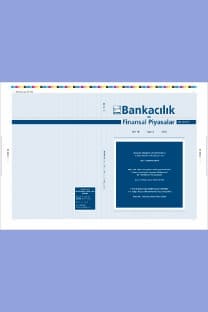Kısa vadeli para politikası aracı olarak faiz düzleştirme kuralı: Teorik ve metodolojik yaklaşım
Interest rate smoothing rule as a short term monetary policy tool: Theoretical and methodological approach
___
- 1. Amato, Jeffery ve Thomas Laubach, (1999). The Value of Interest Rate Smoothing: How The Private Sector Helps The Federal Reserve. Economic Review, Federal Reseve Bank of Kansas, Third Quarter: 47-64.
- 2. Balduzzi, Pierluigi, Giuseppe Bertola ve Silverio Foresi, (1997). A Model of Target Changes and The Term Structure of Interest Rates. Journal of Monetary Economics, 39: 223-249.
- 3. Bullard, James ve Kaushik Mitra, (2000). Determinacy, Learnability, and Monetary Policy Inertia. Federal Reserve Bank of St. Louis Working Paper, 200-030a.
- 4. Clarida, Richard, Jordi Gali ve Mark Getrler, (1999). The Science of Monetary Policy: A New Keynesian Perspective. Journal of Economic Literature, 37: 1667-1707.
- 5. Clarida, Richard, Jordi Gali ve Mark Getrler, (2000). Monetary Policy Rules and Macroeconomic Stability: Evidence and Some Theory. Quarterly Journal of Economics, 115: 147-180.
- 6. Cukierman, Alex, (1991). Why does The FED Smooth Interest Rates?. In Monetary Policy on The 75th Anniversary of The Federal Reserve System, Boston/Dordrecht/London: Kluwer Academic Publishers: 111-144.
- 7. Dotsey, Michael ve Christopher Otrok, (1995). The Rational Expectations Hypothesis of The Term Structure, Monetary Policy and Time-Varying Term Premia. Economic Quarterly, Federal Reserve Bank of Richmond, Winter:65-81.
- 8. Drew, Aaron ve L. Christopher Plantier, (2000). Interest Rate Smoothing in New Zealand and Other Dolar Bloc Countries. Reserve Bank of New Zealand Discussion Paper Series, DP2000/10.
- 9. Driffill John, Zeno Rotondi, Paolo Savona ve Cristiano Zazzara, (2006 ). Monetary Policy and Financial Stability: What Role for The Futures Market?. Journal of Financial Stability, 2: 95-112.
- 10. Eijffinger, Sylvester, Eric Schaling ve Willem Verhangen, (1999). A Theory of Interest Rate Stepping: Inflation Targeting in A Dynamic Menu Cost Model. Tilburg University, Center for Economic Research, Discussion Paper: 71.
- 11. English, William, William Nelson ve Brian Sack, (2003). Interpreting The Significance of The Lagged Interest Rate in Estimated Monetary Policy Rules. Contributions to Macroeconomics, 3:1-16.
- 12. Gerlach-Kristen, Petra, (2004). Interest- Rate Smoohting: Monetary Policy Inertia or Unobserved Variables?. Contributions to Macroeconomics, 4(1): 1169-1186.
- 13. Goodfriend, Marvin, (1987). Interest-Rate Smoothing and Price Level Trend- Stationarity. Journal of Monetary Economics, 19(3): 335-348.
- 14. Goodfriend, Marvin, (1991). Interest Rates and The Conduct of Monetary Policy. Carnegie- Rochester Series on Public Policy, 34: 7-30.
- 15. Goodhart, Charles, (1997). Why Do The Monetary Authorities Smooth Interes Rates?. European Monetary Policy, S. Collignon Edition, Pinter, Washington DC: 119-178.
- 16. Goodhart, Charles, (1999). Central Bankers and Uncertainty. Quarterly Bulletin, Bank of England, 39: 102-115.
- 17. Greene, William H., (1997). Econometric Analysis. New Jersey: Prentice Hall International, Third Edition.
- 18. Issing, Otmar, (2003). Monetary and Financial Stability: Is There a Trade Off?. Conference on Monetary Stability, Financial Stability and The Business Cycle, Bank for International Settlements Basle, March 28-29.
- 19. Judd, John ve Glenn Rudebusch, (1998). Taylor Rule and The Fed: 1990-1997. Economic Review, Federal Reserve Bank of San Francisco.
- 20. Levin, Andrew, Volker Wieland ve John Williams, (1999). Robustness of Simple Monetary Policy Rules Under Model Uncertainty, Monetary Policy Rules. Chicago: Chicago University Pres, John B. Taylor Edition: 263-299.
- 21. Lowe, Philip ve Luci Ellis, (1997). The Smoothing of Official Interest Rates. Reserve Bank of Australia, Monetary Policy and Inflation Targeting.
- 22. Mankiw, N. Gregory ve Jeffrey A. Miron, (1986). The Changing Behavior of The Term Structure of Interest Rates. Quarterly Journal of Economics, 101: 225.
- 23. Montoro, Carlos, (2007). Why Central Banks Smooth Interest Rates? A Political Economy Explanation. Central Reserve Bank of Peru, Working Paper Series, January.
- 24. Orphanides, Athanasios ve Volker Wieland, (2000). Efficient Monetary Policy Design Near Price Stability. Journal of The Japanese and International Economies, 13: 327-365.
- 25. Orphanides, Athanasios, (2004). Monetary Policy Rules, Macroeconomic Stability and Inflation: A View from The Trenches. Journal of Money, Credit and Banking, 2: 151-175.
- 26. Orphanides, Athanasios, Volker Wieland, (1998). Price Stability and Monetary Policy Effectiveness when Nominal Interest Rates are Bounded at Zero. Finance and Economics Discussion Series, Board of Governors of The Federal Reserve System, 35.
- 27. Orphanides, Athanasios, (2007). Taylor Rules. FEDS Working Paper, 18: 1-13.
- 28. Rudebusch, Gleen D., (1995). Federal Reserve Interest Rate Targeting, Rational Expectations and The Trem Structure. Journal of Monetary Economics, 35: 245-274.
- 29. Rudebusch, Glenn D., (2002). Term Structure Evidence on Interest Rate Smoothing and Monetary Policy Inertia. Journal of Monetary Policy, 49: 1161- 1187.
- 30. Sack, Brian ve Volker Wieland, (2000). Interest Rate Smoothing and Optimal Monetary Policy: A Revivew of Recent Empirical Evidence. Journal of Econoimcs and Business, 52: 205-228.
- 31. Sack, Brian, (1998). Uncertainty, Learning and Gradual Monetary Policy. FEDS Working Paper, Federal Reserve Board, 34.
- 32. Taylor, John B., (1993). Discretion Versus Policy Rules in Practice. Carnegie-Rochester Conference Series on Public Policy, North-Holland, 39: 195-214.
- 33. Woodford, Michael, (1999). Optimal Monetary Policy Inertia. NBER Working Paper, 7261: 1-35.
- 34. Woodford, Michael, (2001). The Taylor Rule and Optimal Monetary Policy. American Economic Review, American Economic Association, 91(2): 232-237.
- ISSN: 1307-5705
- Yayın Aralığı: 2
- Başlangıç: 2007
- Yayıncı: Bankacılık Düzenleme ve Denetleme Kurumu
Türkiye’de Zaman Tutarsızlığının ARDL Yöntemi ile İncelenmesi
Talha USTASÜLEYMAN, KEMAL EYÜBOĞLU
Türkiye'de zaman tutarsızlığının ARDL yöntemi ile incelenmesi
Kısa vadeli para politikası aracı olarak faiz düzleştirme kuralı: Teorik ve metodolojik yaklaşım
Veri zarflama analizi ve veri madenciliği ile mevduat bankalarında etkinlik ölçümü
